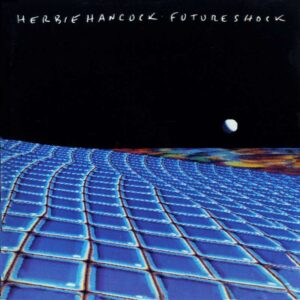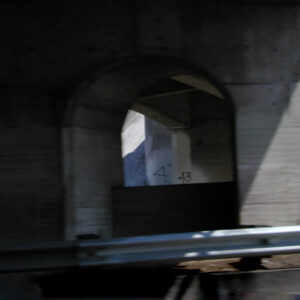
idPURE Magazine Interview with David Em
by Joël Vacheron
You have probably admired the art of David Em without even being aware of it.
In the mid-80s, his artworks were on the covers of the trilogy, Future Shock (1983), Sound System (1984), and Perfect Machine (1988), born from the collaboration between the musicians Herbie Hancock and Bill Laswell. These projects brought computer graphics to a broad audience.

After his studies in painting and film, Em became one of the first artists invited to team up with scientific institutions like Xerox PARC, NASA’s Jet Propulsion Laboratory, and later Apple. This proximity to computer graphics pioneers afforded him the use of powerful technologies to create a visual language that was still unseen in the 70s and the 80s.
In “EM” (1982), a short documentary about his work, David Em is calmly petting a cat in the garden when he talks about the influences that led him to become a groundbreaking actor of digital art.
From his childhood comics to the political and spiritual dimensions of art, one is instantly struck by his highly poetic and inspiring vision. It is strongly reminiscent of contemporary postures when it comes to talk about Net or Postinternet art.
Joël Vacheron: During the 70s, the photographs known as Earthrise and Blue Marble were strong and “realistic” environmental symbols. One decade later, when digital graphics were still unusual in mass consumerism, what were the effects and imaginaries carried in algorithmic landscapes like Approach, used for the iconic album cover of Herbie Hancock’s Future Shock (1983)?
David Em: Before the early 80s, very few people on the planet had seen anything like this, so when my images were first published, they had a tremendous impact. In today’s language, you might say they went “viral,” and were widely reproduced in books, magazines, television, and other media around the world. Other people were making digital images too, of course, quite a few preceding me, but no other artist had created completed art works that instantly conveyed the concept of virtual worlds.
There was a strong emotional component to the public’s reaction. At that time in cultural history, there was a schizophrenic attitude in the society toward high tech in general and computers in particular. On the one hand, there was tremendous fear of technology, based in part on the atomic bomb and free-floating feelings of dehumanization, while on the other, there was the romance of futuristic cars, electric guitars, and man’s first steps on the moon.
Overall, my experience was that the general public was fascinated, while the traditional art world was completely closed to the whole idea.
JV: Considering that Ray Bradbury wrote a text for an exhibition catalogue in 1984, I assume you were a Sci Fi enthusiast. However, what were your other influences influencing your creative process?
DE: Actually, Science Fiction didn’t have much of a direct influence on my images from that period. They were driven much more by Science Fact. I made the pictures at the Jet Propulsion Laboratory (JPL) during the period the first closeup images from Mars and Jupiter came in, and those had a huge influence on my thinking and my aesthetic.
Interestingly, my connection with deep space led me to get to know a number of Science Fiction authors. Ray Bradbury wrote an introduction to a show catalogue, I met Robert Heinlein at JPL, and I worked on several projects with Jerry Pournelle. I also became friends with Ed Emschwiller who in addition to being a colleague, was a well-known Sci Fi illustrator earlier in his career, and Kelly Freas, who was as well.
A bigger direct influence than Sci Fi early in my childhood was comic books. Long before I had any notion of becoming an artist, I studied comics intently. The ones that interested me most often had Sci Fi and Fantasy themes, which gave the artists a lot of leeway to visualize non-ordinary situations and atmospheres. Steve Ditko had a huge effect on me, in particular his pre-Spiderman work, as well as a Mexican comic by German Butzé called Los Supersabios, about a pair of crazy young scientists who had their own independent laboratory, which in retrospect I think made the act of producing art in a computer lab very natural and even romantic to me, while to the art world it represented anathema.
JV: You were working at the JPL when Ronald Reagan was launching the program of Strategic Defense Initiative, the anti-ballistic missile system commonly known as Star Wars. I was wondering if, among your different collaborations with scientific institutions, you were you also invited to produce functional models for the government?
DE: A very interesting point, but it was actually the opposite. JPL is technically a subdivision of Caltech as well as an extension of NASA. While it could be difficult to gain access to the JPL campus in the seventies, once you were in, everything and everyone was open and available. The whole place was focused on the space program, which was thought of as “good-guy technology.” When Reagan came to power, NASA was to a great extent militarized, and became an extension of the Air Force. Space exploration money was drying up, and was increasingly replaced with military contracts, so the tenor at JPL changed. New clearances were required, and some areas became closed access.
The lab where I did my work was a research lab that was supported by a series of contracts to make CG PR films for the media to visualize the flybys of the outer planets. Nobody in the lab was interested in doing military work, so the direction things were going in was less than comfortable. A solution was worked out to relocate the lab to a small facility a few miles away from JPL proper, under the aegis of Caltech. Eventually, the military took over part of that building as well, but there was a virtual firewall between them and us, and we had no contact with each other.
JV: What is the influence of pioneering works like yours in the development and diffusion of entities like the “cyberspace” and other kind of “virtual worlds”? Do you feel your creations produced, as Barthes put it, an effect of reality?
DE: As I mentioned, certain of my images such as Approach (the cover of Future Shock) and Transjovian Pipeline (the cover of Sound System) brought the world’s attention to the whole notion of virtual worlds. It took me a while to grasp many of the implications myself, even as I was producing them. Traveling inside image space, rather than producing and viewing an image through a flat frame or plane, is a fundamentally different experience, and people got that.
One thing that was different in my work from most of what others in the field were trying to accomplish, was that I wasn’t particularly interested in trying to reproduce the real world. At that time no one had figured out how to create realistic, skin, fur, clouds, and that sort of thing. For many years, that was where most of the energy in the field was directed toward in work being done on a high level, mostly with an eye to film animation. My interest in those developments was to use them as part of my growing toolbox for the purpose of experimentation and expression without any predetermined outcome in mind.
JV: Did your works prefigure contemporary debates related to artistic productions generated by algorithms?
DE: I was always interested in the unintended consequences of working with bits. For example, in Approach, the white sphere and the blue foreground grid are imperfect as a result of random perturbations in the code. I was always on the lookout for these sorts of unpredictable and unexpected results that gave the works a unique character derived from the medium itself. I have a keen interest in Emergence in nature and mathematics, although I have reservations about it in terms of music and what we call art.
JV: “At its best, prefigurative politics attempts to embody utopian impulses in bringing the future into concrete existence today.” Would you say your art is a prefigurative aesthetic that brought/brings the future into concrete existence?
DE: I’ve always thought of high technology and aesthetic progress in general, as miraculous gifts from the future. How else to explain them? As to any political aspects of the future leaking into the present, that’s always been a double-edged sword.

JV: Your documentary Graffiti Fever (1978) is probably one of the first accounts about this street art form. Despite it seems far from your computer generated images, how did graffiti influence your own practice and inspiration ?
DE: My early interest in graffiti had a significant impact on the steps that led to working with technology as my metier. Towards the end of my art training in the early seventies in Philadelphia, at a time that I perceived myself as a sculptor, I had started to work with industrial fabrication machinery. This was frowned upon by the faculty, who felt art should not be produced with the aid of machines, a harbinger of what I would confront a few years later when I started producing and exhibiting electronic art.
This was well before graffiti and street art had become the international phenomena they are today. Some of the earliest contemporary graffiti appeared in the streets of Philadelphia at that time, and I was tremendously impressed by its energy, its scale, its originality, and its placement, which constituted a direct dialogue with the public. I began to study and collect it, and in doing so came to appreciate it as a true art form that existed in a space completely independent from the art world.
This perception had a liberating effect on me. It helped me take the crucial steps from fabrication equipment to experimenting with analog video, to digital technology without being concerned about whether or not the traditional art world thought what I was doing was art or not.
